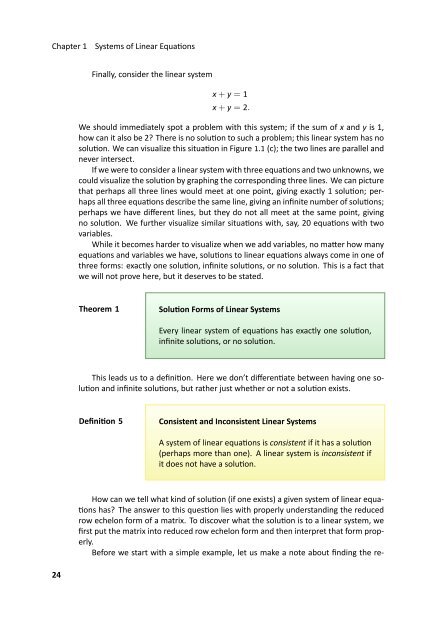Fundamentals of Matrix Algebra, 2011a
Fundamentals of Matrix Algebra, 2011a
Fundamentals of Matrix Algebra, 2011a
You also want an ePaper? Increase the reach of your titles
YUMPU automatically turns print PDFs into web optimized ePapers that Google loves.
Chapter 1<br />
Systems <strong>of</strong> Linear Equaons<br />
Finally, consider the linear system<br />
x + y = 1<br />
x + y = 2.<br />
We should immediately spot a problem with this system; if the sum <strong>of</strong> x and y is 1,<br />
how can it also be 2? There is no soluon to such a problem; this linear system has no<br />
soluon. We can visualize this situaon in Figure 1.1 (c); the two lines are parallel and<br />
never intersect.<br />
If we were to consider a linear system with three equaons and two unknowns, we<br />
could visualize the soluon by graphing the corresponding three lines. We can picture<br />
that perhaps all three lines would meet at one point, giving exactly 1 soluon; perhaps<br />
all three equaons describe the same line, giving an infinite number <strong>of</strong> soluons;<br />
perhaps we have different lines, but they do not all meet at the same point, giving<br />
no soluon. We further visualize similar situaons with, say, 20 equaons with two<br />
variables.<br />
While it becomes harder to visualize when we add variables, no maer how many<br />
equaons and variables we have, soluons to linear equaons always come in one <strong>of</strong><br />
three forms: exactly one soluon, infinite soluons, or no soluon. This is a fact that<br />
we will not prove here, but it deserves to be stated.<br />
.<br />
Ṫheorem 1<br />
Soluon Forms <strong>of</strong> Linear Systems<br />
.<br />
Every linear system <strong>of</strong> equaons has exactly one soluon,<br />
infinite soluons, or no soluon.<br />
This leads us to a definion. Here we don’t differenate between having one soluon<br />
and infinite soluons, but rather just whether or not a soluon exists.<br />
.<br />
Ḋefinion 5<br />
Consistent and Inconsistent Linear Systems<br />
.<br />
A system <strong>of</strong> linear equaons is consistent if it has a soluon<br />
(perhaps more than one). A linear system is inconsistent if<br />
it does not have a soluon.<br />
How can we tell what kind <strong>of</strong> soluon (if one exists) a given system <strong>of</strong> linear equa-<br />
ons has? The answer to this queson lies with properly understanding the reduced<br />
row echelon form <strong>of</strong> a matrix. To discover what the soluon is to a linear system, we<br />
first put the matrix into reduced row echelon form and then interpret that form properly.<br />
Before we start with a simple example, let us make a note about finding the re-<br />
24

















